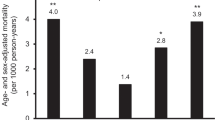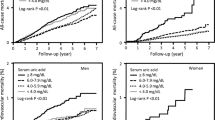Abstract
Although elevated serum uric acid has been associated with an increased risk of cardiovascular disease, its importance as a risk factor is still controversial. The authors examined the relationship between serum uric acid levels and death from all causes, including cardiovascular disease and stroke. The baseline data were collected in the National Cardiovascular Survey in 1980. The survey was carried out for all household members aged 30 years or older in 300 districts, which were randomly selected throughout Japan. The number who participated in the survey was 10,897. The vital status was ascertained in 1994. Finally, 8172 subjects were available for the analyses. There were 108,284 person-years of follow-up, and 960 deaths from all causes, 249 deaths from cardiovascular disease, and 174 deaths from stroke. After adjustment for age and other cardiovascular disease risk factors, uric acid levels were not associated with mortality from all causes, cardiovascular disease, or stroke. These findings indicate that serum uric acid levels are not related to increased risk for death from all causes, including cardiovascular disease and stroke in a Japanese population.
Similar content being viewed by others
References
Gertler MM, Garn SM, Levine SA. Serum uric acid in relation to age and physique in health and in coronary heart disease. Ann Intern Med 1951; 34: 1421–1431.
Kohn PM, Prozan GB. Hyperuricemia – relationship to hypercholesteremia and acute myocardial infarction. JAMA 1959; 170: 1909–1912.
Klein R, Klein BE, Cornoni JC, et al. Serum uric acid. Its relationship to coronary heart disease risk factors and cardiovascular disease, Evans County, Georgia. Arch Intern Med 1973; 132: 401–410.
Brand FN, McGee DL, Kannel WB, Stokes J III, Castelli WP. Hyperuricemia as a risk factor of coronary heart disease: The Framingham Study. Am J Epidemiol 1985; 121: 11–18.
Freedman DS, Williamson DF, Gunter EW, Byers T. Relation of serum uric acid to mortality and ischemic heart disease. The NHANES I Epidemiologic Followup Study. Am J Epidemiol 1995; 141: 637–644.
Bengtsson C, Lapidus L, Stendahl C, Waldenstroem J. Hyperuricemia and risk of cardiovascular disease and overall death. A 12-year follow-up of participants in the population study of women in Gothenburg, Sweden. Acta Med Sand 1988; 224: 549–555.
Reunanen A, Takkunen H, Knekt P, Aromaa A. Hyperuricemia as a risk factor for cardiovascular mortality. Acta Med Scand Suppl 1982; 668: 49–59.
Lehto S, Niskanen L, Ronnemaa T, Laakso M. Serum uric acid is a strong predictor of stroke in patients with non-insulin-dependent diabetes mellitus. Stroke 1998; 29: 635–639.
Alderman MH, Cohen H, Madhavan S, Kivlighn S. Serum uric acid and cardiovascular events in successfully treated hypertensive patients. Hypertension 1999; 34: 144–150.
Serum uric acid: Its association with other risk factors and with mortality in coronary heart disease. The Coronary Drug Project Research Group. J Chron Dis 1976; 29: 557–569.
Yano K, Reed DM, McGee DL. Ten-year incidence of coronary heart disease in the Honolulu Heart Program: Relationship to biologic and lifestyle characteristics. Am J Epidemiol 1984; 119: 653–666.
Wannamethee SG, Shaper AG, Whincup PH. Serum urate and the risk of major coronary heart disease events. Heart 1997; 78: 147–153.
Facchini F, Chen Y-D, Hollenbeck CB, Reaven GM. Relationship between resistance to insulin-mediated glucose uptake, urinary uric acid clearance, and plasma uric acid concentration. JAMA 1991; 266: 3008–3011.
Culleton BF, Larson MG, Kannel WB, Levy D. Serum uric acid and risk for cardiovascular disease and death: The Framingham Heart Study. Ann Intern Med 1999; 131: 7–13.
Ministry of Health and Welfare. National Survey on Circulatory Disorders 1980. Tokyo: Japan Heart Foundation, 1982.
Cox DR. Regression models and life tables (with discussion). J R Stat Soc Appl Stat Sect (B) 1972; 34: 187–220.
SAS/STAT Software: Changes and Enhancements through Release 6.11. Cary, NC: SAS Institute, 1996.
Bonita R, Stewart A, Beaglehole R. International trends in stroke mortality: 1970–1985. Stroke 1990; 21: 989–992.
Fang J, Alderman MH. Serum uric acid and cardiovascular mortality. The NHANES I Epidemiologic follow-up study, 1971–1992. JAMA 2000; 283: 2404–2410.
Harris MI, Hadden WC, Knowler WC, Bennett PH. Prevalence of diabetes and impaired glucose tolerance and plasma glucose levels in U.S. population aged 20–74 yr. Diabetes 1987; 36: 523–534.
Nakanishi N, Tatara K, Nakamura K, Suzuki K. Risk factors for the incidence of hyperuricemia: A 6-year longitudinal study of middle-aged Japanese men. Int J Epidemiol 1999; 28: 888–893.
Modan M, Halkin H, Karasik A, Lusky A. Elevated serum uric acid – a facet of hyperinsulinaemia. Diabetologia 1987; 30: 713–718.
Rathmann W, Funkhouser E, Dyer AR, Roseman JM. Relations of hyperuricemia with the various components of the insulin resistance syndrome in young black and white adults: The CARDIA Study. Ann Epidemiol 1998; 8: 250–261.
Adachi H, Jacobs DR Jr, Hashimoto R, Tsuruta M, Imaizumi T. Clustering of cardiovascular risk factors in hyperinsulinemia in Japanese without diabetes. Diabetes Res Clin Pract 1998; 40: 181–190.
Bonora E, Targher G, Zenere MB, et al. Relationship between fasting insulin and cardiovascular risk factors is already present in young men: The Verona Young Men Atherosclerosis Risk Factors Study. Eur J Clin Invest 1997; 27: 248–254.
Galvan AQ, Natali A, Baldi S, et al. Effect of insulin on uric acid excretion in humans. Am J Physiol 1995; 268: E1–E5.
Cappuccio FP, Strazzullo P, Farinaro E, Trevisan M. Uric acid metabolism and tubular sodium handling – Results from a population-based study. JAMA 1993; 270: 354–359.
Author information
Authors and Affiliations
Rights and permissions
About this article
Cite this article
Sakata, K., Hashimoto, T., Ueshima, H. et al. Absence of an association between serum uric acid and mortality from cardiovascular disease: NIPPON DATA 80, 1980–1994. Eur J Epidemiol 17, 461–468 (2001). https://doi.org/10.1023/A:1013735717961
Issue Date:
DOI: https://doi.org/10.1023/A:1013735717961




